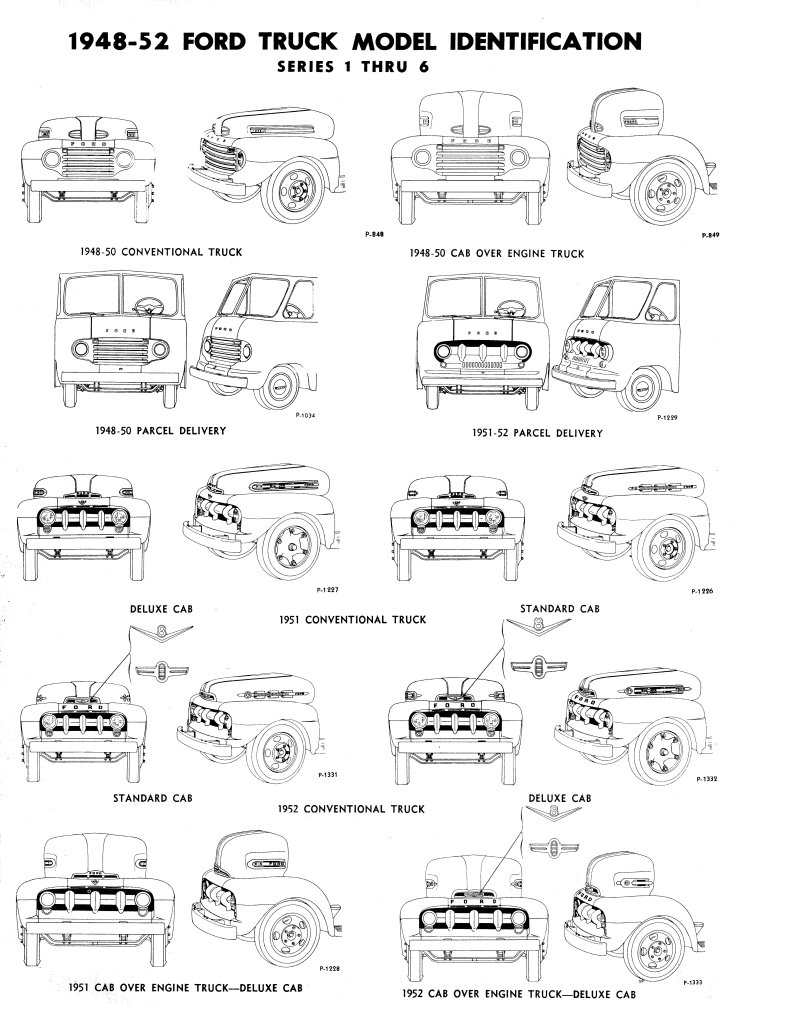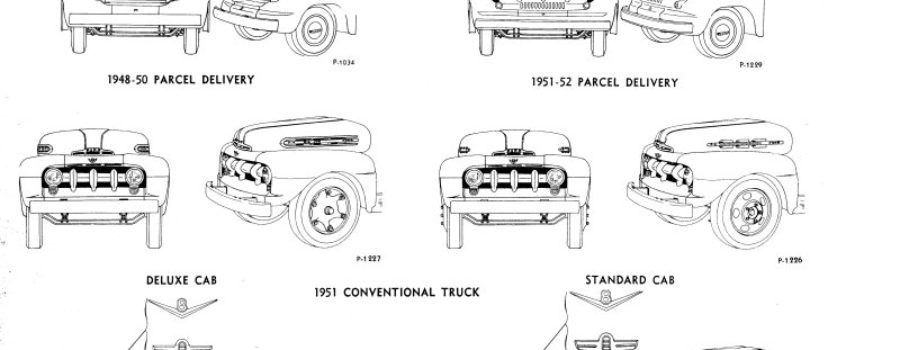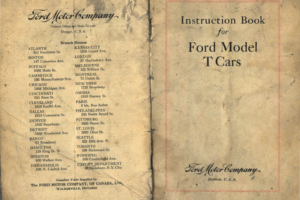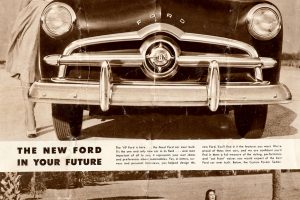| Sourced From http://fatfenderedtrucks.com | |
| Parts differences between 1948-50 and 1951-52 model years. | Cabs are different: 1948-50 have different dash arrangement, one dash pod, kind of a side wards tombstone shape, that has the speedometer and engine gauges. Cab has a small rear widow. 1948-50 radio is all it’s own. It is very similar to the ’48 Mercury but has a beige bezel and different mounting brackets. The radio was mounted high in the center of the dashboard.  1951-52 dash has two round dash pods, one is the speedometer, the other have the engine gauges. Cab has wide rear window. 1951-52 also came with the Five Star option consisting of dual electric windshield wipers, stainless windshield trim, inner door panels and arm rests. 1951-52 radio mounts low in the center of the dashboard and is the same radio used in the cars of the same year. Front sheet metal is different: Entire front clip from one style will bolt onto the other but you cannot mix parts. The front fenders from one style will not fit with the grill and hood latch for the other style. The hood can be swapped but will need major modification to work with the other latching mechanism. Inner fender panels are different and cannot be used from one style to the other. Boxes for the F-2 and F-3 are basically the same through the five model years but boxes for the F-1 models are different: 1948 to early 1950 have raised sides along with notches in the mating surface of rear fenders. Late 1950-52 have flat sides along with flat mating surface of rear fenders. Tailgates are different, the latches are mounted at different heights. Although the above specified parts are different for model year style you can still mount these items on all the frames made from 1948 to 1952 with little or no modification.  |
| With the above stated about the differences between the 1948-50 and 1951-52 models years the following pertains to the parts shared between the same model year styling | |
| Parts shared by all Models, F-1 through F-8 (including panel trucks) | Cab (except panel), doors and interior cab parts (Except speedometer and transmission covers, the trans cover will fit all models but will need to have holes closed and moved around.) Inner fender panels Doors Hood |
| Parts specific to F-1 | Front fenders Pickup box (6 ½ foot), mid 1950 model year the box was changed to flat sides. The new style was used through the 1952 model year. Rear fenders, mid 1950 model year the fender no longer had the step to follow the raised panel. Tailgate, tailgate was changed in mid 1950 model year. The gate chain latch was moved. Running boards, boards were changed in mid 1950 model year. The wide flange that ran under the cab and box was gone. Boards will still work with the later model trucks. |
| Parts shared by F-1 through F-6 | Grill Radiator support Short running boards (With slight alteration these also fit panel trucks) |
| Parts shared by F-2 through F-6 | Front fenders |
| Parts shard by F-2 and F-3 | Front fenders (wheel openings are larger than the F-1) Pickup box (8 foot and wider than the F-1, wheel well protrude further into the box) Tailgate (wider and higher that the F-1) Rear fenders (wheel opening is larger and is narrower that the F-1) Running boards are about 6″ longer than the F-1. F-2 and F-3 trucks with flat beds used the same short running boards as the F-4, F-5 and F-6. The same short running boards were use on ’48-52 F-1 panel trucks but were slightly altered with a notch to accommodate the body of the panel truck. Click HERE to how. Boards were changed in mid 1950 model year. The wide flange that ran under the cab and box was gone. Boards will still work with the later model trucks. |
| Parts shared by F-7 and F-8 | Grill (wider than the smaller models) Front fenders (wider than the smaller models) Running boards (7 inches wider than smaller models) |
| Bumpers | F-1, F-2 and F-3 models share the same front bumpers. 1948-50 have smooth bumpers, 1951 and 52 trucks have a ribbed bumpers. F-4, F-5 and F-6 models share the same front bumpers. The bumpers are thicker, top to bottom, than the smaller trucks. F-7 and F-8 models share the same front bumpers, along with COE and vanettes. |
| Differences between 6 cylinder and 8 cylinder trucks | The battery trays mounts on opposite sides Starter solenoid mounts near batteries so they are on opposite sides too Radiator sets closer to the front on a 6 cylinder truck Radiator panel in the hood on a six cylinder truck also sets closer to the front of the truck and is narrower than the 8 cylinder panel. Throttle linkages are different; the linkage on the eight comes up above the engine, toward the middle of the engine; the six’s linkage runs to the passenger side of the engine and runs along the manifolds. Fuel line on the eight runs up the firewall on the driver’s side and connects to the fuel pump on the back corner of the engine; the fuel line on the six crosses the transmission frame support, runs along the passenger side frame and connects to the fuel pump on the front of the engine. |
| COE and delivery vans | Grill (same as the F-7 & 8’s) I am not familiar with COE trucks or delivery vans (bread truck vans) so this is the only information I have about these models. |
Was this article a help? Consider supporting the Flat-Spot by becoming a Premium Member. Members get discounts with well known retailers, a cool membership packet full of goodies and your membership goes toward helping us upkeep and expand on this great archive.











